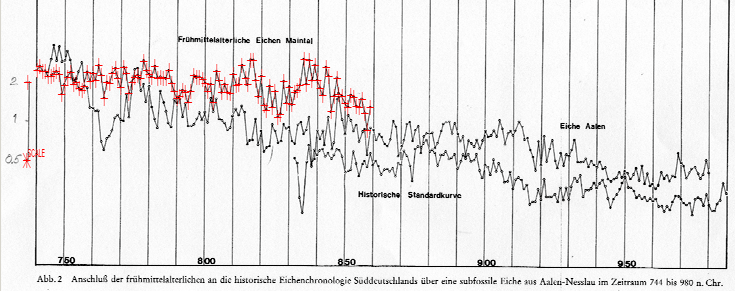The Becker BC 370 - AD 1950 chronology
In contrast to Hollstein, Beckers data is not backed up by extensive curve drawings. So we have no way to validate the curve building process.

I have copied that table by hand and converted the data into a member of an .rwl file, see below.
The chronology anchoring process
To anchor this curve into the then current late time chronology, starting at 832, he needed and found a stem, the Eiche Aalen, that should bridge the time gap.
In a curve diagram, shown below, he demonstrates how the Eiche Aalen matches the historical standardcurve and how his new chronology matches the Eiche Aalen.
I've found it most interesting to study this anchoring process. That analysis is found in the next section.
For this discussion, we need to retrieve the curve data from Becker's diagram below.

There are three curves on the picture, from top to bottom:
1. The early middle age oak chronology from the river Main valley (Frühmittelalterliche Eichen Maintal).
2. "Eiche Aalen", the subfossile oak stem from Aalen-Nesslau.
3. The historical standard curve
The red crosses are my measurement points on the chronology curve at the top.
The two top curves, seem to cross each other at year 757, where they share a ring in the diagram.
That means that the chronology curve (1) goes back to year 740 at the left edge of the diagram where it certainly continues out of sight.
The Eiche Aalen curve (2) then starts at year 744, crosses the chronology curve (1) at year 757 and continues to year 980.
The Historical standard curve starts at year 832 and the curve plot ends with the right margin at year 986 (where it continues out of sight).
It is to be noted again that the ring widths are relative and not absolute as there is no scale published with the diagram.
The scale to the left in the diagram above is drawn by me to enable the conversion program to interpret the coordinate data.
The Becker chronology data file

BeckerChronology.rwl
The Becker Roman time curves
In a diagram on page 381 of his article, Becker publishes eight curves covering year BC 20 - AD 180 of Roman time.I have measured these curves with CooRecorder and converted them to ring width curves.
There are a number of cases where there are not nine small rings on a curve segment between each vertical line of the diagram.
In these cases, I have considered this as a drawing mistake and corrected it by inserting the missing point in the middle of the straight line.
These mistakes are found at:
Aalen: ring at year 132 missing.
Murrhardt: A redundant ring between year 100 and 110.
(Note that Aalen and Murrhardt curves cross each other at year 113.)
Mainhardt: missing at 51, 79 and 151.
Rainau Buch: missing at BC 9.
In the case of the redundant ring, I have removed a ring where crossdating showed it to be most probable.

which is available for your research purposes as BeckerRomanSamples.rwl
Dating: The dating in the diagram is misleading. Crossdating of the curves to either our Hollstein Roman chronology or Beckers mean value chronology says that the right margin of the diagram corresponds to year AD 181 (and not 180). Curves crossing: The Welzheim and Schwabsberg curves seem to cross each other at their late end. As the meaning of this drawing is not clear, I decided to discard the last ring of both these two curves, which means that their end years are modified compared to the curve drawings.
Continue with the next section!
|
|